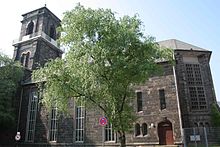Marked church
The Gemarker Kirche is a Protestant church in the Wuppertal district of Barmen , where the Barmen Confessing Synod of the German Evangelical Church passed the Barmen Theological Declaration on May 31, 1934 .
history
First construction
On August 8, 1702, Duke Johann Wilhelm II of Jülich and Berg approved the establishment of an independent Protestant Reformed community in Barmen. But it wasn't until a decade later, on May 19, 1710, that the foundation stone for a church was laid. The property on the district, which gave its name to the young community and the church to be built, was made available by the Barmer merchant Peter Wichelhausen. At first the construction progressed rapidly; but on February 29, 1712 the church tower that had just been completed collapsed because the muddy ground was unable to support the structure.
Nevertheless, on June 17, 1714, the first service was celebrated in the Gemarker church. In the following decades the village of Gemarke was formed around the church. On June 8, 1719, the second building of a church tower began; However, construction had to be stopped again in 1721, as the immense construction costs could no longer be covered. In 1727 the church tower was finally completed.
Second construction
Since the community grew rapidly in the 19th century due to industrialization , the church building soon became too small. So the Gemarker presbytery decided to build a new one. The first Gemarker church was closed and demolished in the late summer of 1887. From autumn 1887 to 1890 a larger church was built on the same site by the master builders Bummerstedt, Bremen , and Berger, Wiesbaden , who had previously built the Christ Church under Mercy . The interior of the eclectic central building was around 25 m long, 27 m wide and 16 m high. The four-part church tower was 70 m high and bordered on both sides by two stair turrets. The historical window and portal shapes were based on the Renaissance . The principal pieces including the organ front were arranged one above the other. The church offered a total of 1,300 people.
Large parts of Barmens were destroyed by a British air raid on the night of May 30, 1943. The Gemarker church burned down to the outer walls.
On May 19, 1955, Ascension Day, the first service could finally take place in the rebuilt, but much smaller Gemarker church.
literature
- Caspar Eberhardi: History of the founding of the Reformed community in the district . Steinhaus, Barmen 1867 ( digitized version ).
- Sigrid Lekebusch, Florian Speer : Churches and places of worship in Wuppertal, Volume 2: Churches and places of worship in Barmen (= contributions to the history and local history of the Wuppertal, vol. 43). Wuppertal 2008, ISBN 978-3-87707-721-4
- Fritz Mehnert (ed.): Oberbarmer community history. District, Wichlinghausen, Wupperfeld, Hatzfeld, Heidt, Heckinghausen. Wuppertal 2002.
- Robert Steiner: trademark 1702–1977. Brief history of the Evangelical Reformed Community of Barmen-Gemarke. Wuppertal 1977.
- Adolf Werth: History of the reformed community Barmen-Gemarke. A festival sheet for the 200th anniversary. Barmen 1902. Continued and supplemented edition, ed. by Adolf Lauffs, Barmen 1927.
Web links
- Entry in the Wuppertal monument list
- Internet presence of the Evangelical Church Community Gemarke-Wupperfeld in Barmen
Individual evidence
- ↑ Building description: In Deutsche Bauzeitung No. 10, February 1, 1890 (PDF; 9.9 MB), accessed on December 24, 2012
Coordinates: 51 ° 16 ′ 16 ″ N , 7 ° 11 ′ 52 ″ E






